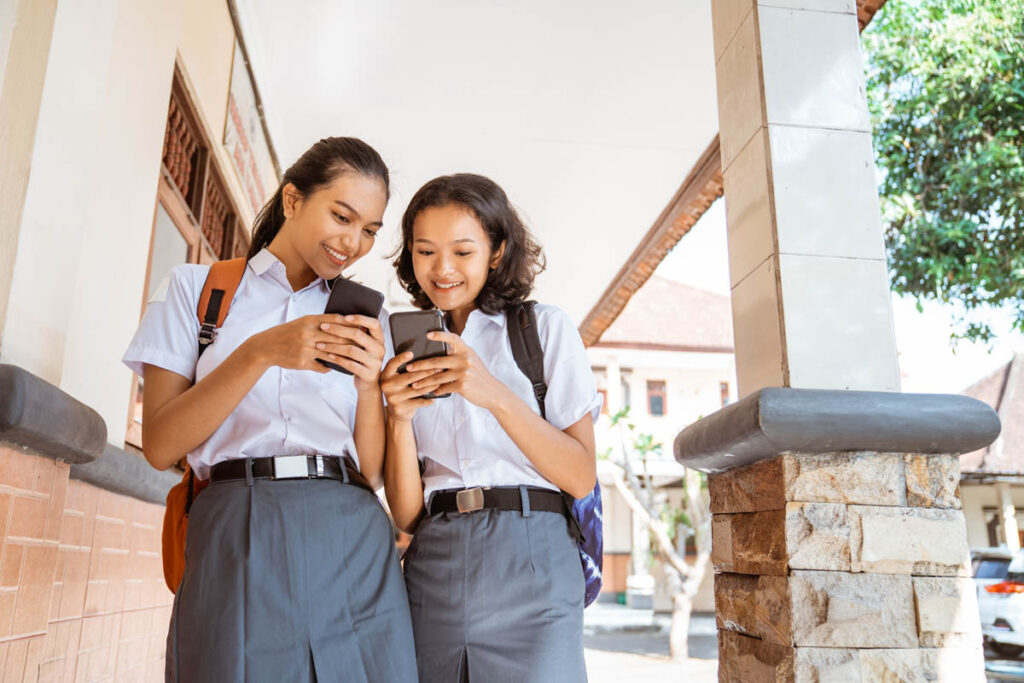If you’ve ever peeked into your teen’s room at night and caught the glow of a phone under the covers, you’re not alone. Paradigm Treatment has worked with countless families addressing the complex relationship between social media and sleep. The pattern is familiar: casual scrolling turns into a cycle that disrupts rest, academics, and relationships. Understanding how these digital habits affect your teen is the first step toward helping them find balance.
Let’s explore how social media affects sleep, school performance, and social connections, and what you can do to support healthier habits.
Table of Contents
- Key Takeaways
- How Does Social Media Disrupt Teen Sleep Patterns?
- How Is Social Media Affecting Relationships and Social Skills?
- What Is the Social Media Influence on Education?
- What Are the Warning Signs of Problematic Social Media Use?
- How Can You Help Teens Build Healthier Digital Habits?
- When Should You Seek Professional Help?
- Frequently Asked Questions
- Supporting Your Teen in Finding Digital Balance
- Sources
Key Takeaways
- Poor sleep from social media use impacts emotional stability, academic performance, and relationships
- Teens may not recognize how digital habits harm their well-being
- Setting boundaries and promoting offline activities can restore balance
- Professional help is essential when overuse becomes compulsive
- Paradigm Treatment offers specialized care for teens facing technology-related challenges
How Does Social Media Disrupt Teen Sleep Patterns?
Social media affects sleep by stimulating the brain and delaying melatonin release, the hormone that signals it’s time to rest. Platforms are designed to keep users engaged with infinite scroll, autoplay videos, and frequent notifications. For teens with developing brains, resisting these tactics is especially challenging.
Studies have found that teens using screens within an hour of bedtime are significantly more likely to experience sleep disturbances. But blue light isn’t the only problem. Social media content triggers reactions that keep the brain active long after the screen is off.
A new message creates excitement. A post they weren’t tagged in sparks anxiety. These emotional spikes delay deep, restorative sleep. Research consistently shows that social media is linked to poor sleep among teens.
The Emotional Activation Cycle
Scrolling before bed leaves teens emotionally activated, anxious, and wired. Even when they’re physically in bed, their minds stay engaged with what they’ve seen online. Maybe it’s a party they weren’t invited to or a friend’s post that triggers insecurity. That emotional reaction lingers, keeping their thoughts racing into the early hours.
FOMO is a powerful driver. Studies show that teens feel anxious when they can’t check their phones. That anxiety fuels compulsive checking, which disrupts sleep and creates a cycle of exhaustion and emotional burnout.
This loop of scrolling, reacting, and returning for more can delay sleep for hours. It also sets the stage for chronic fatigue and mood instability. When sleep deprivation becomes chronic, it can contribute to teen depression.
How Is Social Media Affecting Relationships and Social Skills?

Social media affecting relationships is more than a trend: it’s reshaping how teens connect and communicate. Teens increasingly rely on digital validation, which weakens real-life communication and emotional connections. When they spend more time curating their online persona than engaging face-to-face, relationships suffer.
Your child might pull away from family dinners, avoid eye contact, or skip outings with friends. Comparison culture intensifies this dynamic. Seeing highlight reels of others’ lives leads to jealousy and insecurity.
Impact on Romantic Relationships
In romantic relationships, social media sparks arguments over likes, comments, or perceived online flirtations.
The issue of social media affecting relationships isn’t just about screen time. It’s about a shift in where teens seek connection and validation. When validation comes primarily from screens, real-world relationships suffer.
What Is Social Media’s Influence on Education?
Multitasking with social media during homework reduces focus, retention, and achievement. Teens toggle between assignments and social apps. This constant switching fragments attention and makes learning less effective.
Research shows that multitasking with social media significantly lowers retention and increases task completion time. Over time, this leads to:
- Declining grades
- Missed deadlines
- Drop in academic confidence
- Increased stress around schoolwork
Teachers report that once-engaged students become distracted or apathetic. If your teen’s school performance is slipping alongside poor sleep or emotional withdrawal, social media influence on education may be a contributing factor.
The Sleep-Academic Performance Connection
When paired with sleep deprivation from late-night scrolling, the academic effects compound. Sleep-deprived teens struggle to concentrate, remember information, and maintain motivation. If your teen’s grades are slipping and they seem tired or irritable, social media’s impact on learning could be key.
What Are the Warning Signs of Problematic Social Media Use?
Watch for emotional distress, declining academics, and withdrawal from offline life. Not every teen who spends time online has a problem, but there are red flags:
Key Warning Signs:
- Irritability when disconnected: Anxiety or upset when separated from their phone
- Loss of interest in offline activities: Hobbies, sports, and meals replaced with screen time
- Academic struggles and poor sleep: These issues often go hand-in-hand
- Emotional withdrawal: Avoiding real-life interactions while becoming more invested in online persona
- Physical symptoms: Headaches, eye strain, or changes in appetite
Behavioral health professionals caution that these signs may indicate deeper issues like anxiety, low self-esteem, or tech dependency. Recognizing the patterns early can prevent more serious concerns.
How Can You Help Teens Build Healthier Digital Habits?
Start with small, consistent changes, like screen-free time before bed and device-free zones. You don’t need a full digital detox. Focus on simple, sustainable routines:
Practical Steps for Better Digital Balance:
- Create a tech-free buffer before bedtime. Aim for 30-60 minutes of screen-free time to let the brain wind down. Reading, journaling, or listening to calming music helps signal the body it’s time to sleep.
- Establish device-free zones. Keep phones out of bedrooms and off the dinner table to encourage face-to-face conversations.
- Encourage offline activities. Support hobbies that build confidence: sports, art, volunteering, or time with friends in person.
- Practice mindfulness techniques. Journaling, deep breathing, or guided meditation helps teens recognize how digital habits affect their mood and energy.
- Model balanced tech use. Teens notice your habits. When you set boundaries for yourself, it normalizes healthy digital behavior.
These shifts can break the cycle of overstimulation and help your teen reconnect with themselves and others. The goal is to create space for rest, reflection, and real connection.
When Should You Seek Professional Help?
If social media use interferes with sleep, school, relationships, or mental health, structured support may be necessary. Sometimes digital habits become compulsive despite your best efforts. If your teen struggles with emotional regulation, academic performance, or social connections, it may be time to consider professional care.
Signs That Professional Support May Help:
- Sleep problems persist despite setting boundaries
- Academic performance continues declining
- Social withdrawal becomes more pronounced
- Emotional distress increases when offline
- Physical symptoms develop
Paradigm Treatment provides comprehensive support for teens struggling with technology overuse. Their programs address both behavior and underlying emotional needs. They combine evidence-based therapies like Cognitive Behavioral Therapy (CBT) and Dialectical Behavior Therapy (DBT) with academic support and family involvement.
Teens learn to understand the emotional drivers behind their social media use, whether it’s stress, loneliness, or low self-worth. They develop healthier coping strategies. The goal isn’t to eliminate technology, but to help teens create a balanced, intentional relationship with it.

Frequently Asked Questions
Q: How does social media impact teen sleep?
It delays melatonin production and keeps the brain emotionally stimulated, making it harder to fall and stay asleep.
Q: Can poor sleep from social media use affect school performance?
Yes. Sleep deprivation reduces focus, memory, and motivation, often leading to academic struggles.
Q: What are the signs that social media is negatively affecting my teen?
Look for emotional distress when disconnected, withdrawal from offline life, declining grades, and disrupted sleep patterns.
Q: How can I set limits without causing conflict?
Involve your teen in creating boundaries. Frame it as a shared goal and offer appealing offline alternatives.
Supporting Your Teen in Finding Digital Balance
The relationship between social media and sleep is more than just a bedtime issue. It touches every part of your teen’s life: mood, grades, and social connections. But you’re not powerless in helping them find balance.
Start by observing patterns and having honest, nonjudgmental conversations. Make small, consistent changes that promote rest and real-life engagement. Building healthier habits takes time and patience.
If your teen seems overwhelmed or if problems persist, don’t hesitate to seek support. With the right guidance and understanding, teens can learn to use technology as a tool rather than letting it control their sleep, relationships, and future success.
Ready to get started on helping your teen? Contact our team today.
Sources
- American Academy of Pediatrics. (2016). Media use in school-aged children and adolescents. Pediatrics, 138(5), e20162592. https://publications.aap.org/pediatrics/article/138/5/e20162592/60321/Media-Use-in-School-Aged-Children-and-Adolescents
- Pew Research Center. (2023, December 13). Teens, social media and technology report. https://dig.watch/updates/pew-research-center-releases-2023-teens-social-media-and-technology-report
- Sleep Foundation. (2023, March 13). How screen time may cause insomnia in teens. https://www.sleepfoundation.org/teens-and-sleep/screen-time-and-insomnia-for-teens
- Sleep Foundation. (2025, July 9). Sleep & social media: Staying connected can keep you up. https://www.sleepfoundation.org/how-sleep-works/sleep-and-social-media
- University of California, San Francisco. (2019, October 21). Social media use and adolescent sleep patterns. Sleep Health, 5(6), 652–661. https://pmc.ncbi.nlm.nih.gov/articles/PMC6830469/





 November 7, 2025
November 7, 2025 Reading Time: 8m
Reading Time: 8m